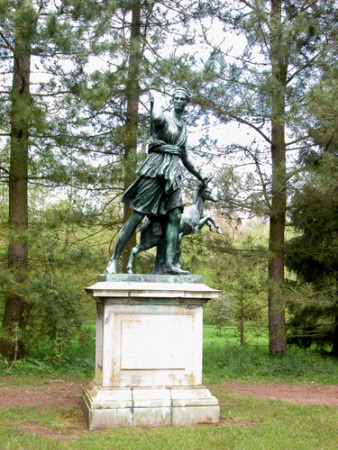Diana the Huntress (Diana of Versailles)
attributed to French School
Category
Art / Sculpture
Date
c. 1875 - 1925
Materials
Bronze
Measurements
2000 x 1250 x 750 mm
Place of origin
France
Order this imageCollection
Anglesey Abbey, Cambridgeshire
NT 515145
Summary
Bronze, Diana the Huntress (Diana of Versailles), after the antique, probably French. An over life-size bronze copy of the Diana of Versailles (Diane Chasseresse), a 2nd century Roman marble statue after a lost Greek bronze (c. 330 BC) in The Louvre (inv. no. MR 152/ Ma 589). Mounted on a panelled stone plinth. Diana was the Roman goddess of the hunt and chastity, known as Artemis in Greek mythology. Wearing a lunate crown, short chiton, himation around the waist and sandals, Diana, looking to proper right, springs forward on her proper left foot, as if in the midst of the hunt, drawing an arrow from her quiver with her proper right hand. In her proper left hand she holds the handle of a bow (the arc of the bow lost in the original marble), while a young buck prances beside her, rearing on its hind legs.
Full description
The original marble was discovered in Italy at either the Temple of Diana Nemorensis or at Hadrian's Villa, Tivoli, and given as a gift from Pope Paul IV to Henry II of France in 1556. One of the first antique sculptures to be seen in France, it was mounted prominently in the Jardin de la Reine at the palace of Fontainebleau. In 1602 it was removed to a specially-designed gallery, the Salle des Antiques, in the Palais du Louvre, Paris, and restored by the sculptor Barthélemy Prieur (1536-1611) who produced a replica cast in bronze for Fontainebleau. Another full-size cast in bronze was made from French moulds by Hubert Le Sueur (c.1580-1670) in 1634 for Charles I, the brother-in-law of Louis XIII; this copy was brought to Windsor Castle in 1829 (RCIN 71444). The marble statue was moved by Louis XIV to the Hall of Mirrors at Versailles, before being returned to the Louvre in the First Republic. The statue was purchased by Lord Fairhaven in August 1949 from Bert Crowther who claimed it originally stood at Ashton Manor near Exeter, Devon. Alice Rylance-Watson 2019
Provenance
Formerly at Ashton Manor, Devon; purchased by Urban Huttleston Rogers Broughton, 1st Lord Fairhaven (1896-1966) from Bert Crowther of Syon Lodge, 26 August 1949, £500.0.0; bequeathed to the National Trust by Lord Fairhaven with the house and the rest of the contents.
Credit line
Anglesey Abbey, The Fairhaven Collection (The National Trust)
Makers and roles
attributed to French School, founder
References
Haskell and Penny 1981: Francis Haskell and Nicholas Penny, Taste and the Antique, The Lure of Classical Sculpture 1500 - 1900, New Haven and London, 1981, pp. 196-7, no. 30. Roper 1964: Lanning Roper, The Gardens of Anglesey Abbey, Cambridgeshire. The Home of Lord Fairhaven, London 1964, p. 86, p. 72. Christie, Manson & Woods 1971: The National Trust, Anglesey Abbey, Cambridge. Inventory: Furniture, Textiles, Porcelain, Bronzes, Sculpture and Garden Ornaments’, 1971, p. 165.


